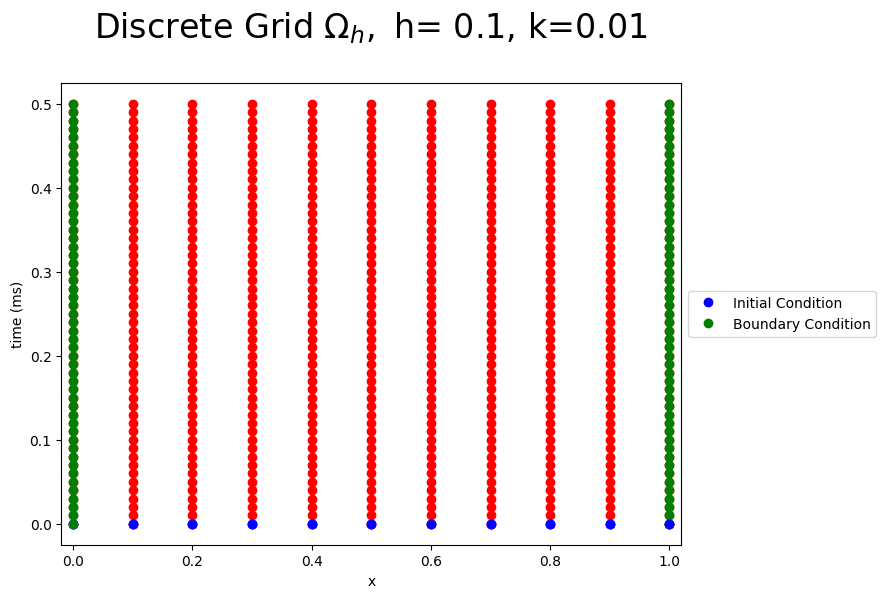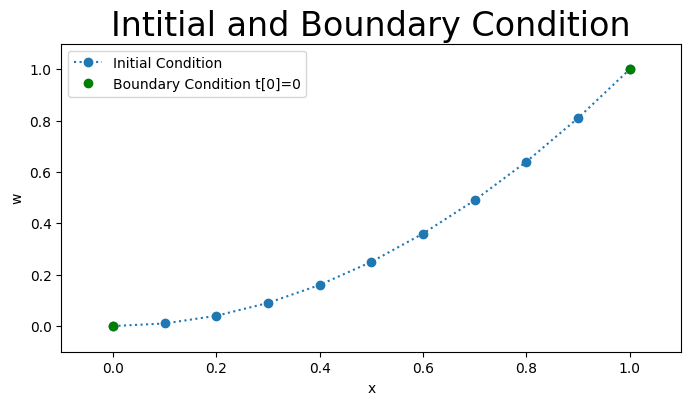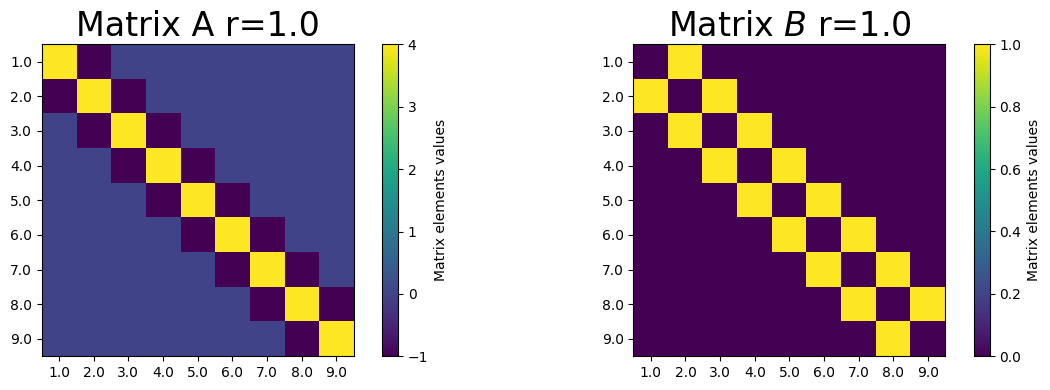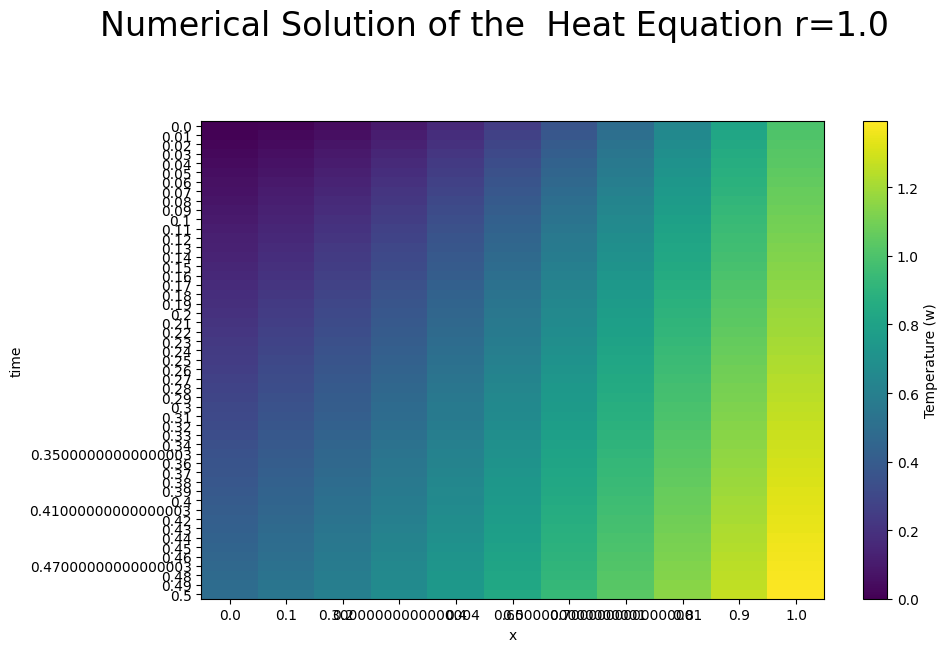The Implicit Crank-Nicolson Difference Equation for the Heat Equation#
The Heat Equation#
The Heat Equation is the first order in time (\(t\)) and second order in space (\(x\)) Partial Differential Equation:
The equation describes heat transfer on a domain
with an initial condition at time \(t=0\) for all \(x\) and boundary condition on the left (\(x=0\)) and right side (\(x=1\)).
Crank-Nicolson Difference method#
This note book will illustrate the Crank-Nicolson Difference method for the Heat Equation with the initial conditions
and boundary condition
# LIBRARY
# vector manipulation
import numpy as np
# math functions
import math
# THIS IS FOR PLOTTING
%matplotlib inline
import matplotlib.pyplot as plt # side-stepping mpl backend
import warnings
warnings.filterwarnings("ignore")
Discete Grid#
The region \(\Omega\) is discretised into a uniform mesh \(\Omega_h\). In the space \(x\) direction into \(N\) steps giving a stepsize of
resulting in
and into \(N_t\) steps in the time \(t\) direction giving a stepsize of
resulting in
The Figure below shows the discrete grid points for \(N=10\) and \(N_t=15\), the red dots are the unknown values, the green dots are the known boundary conditions and the blue dots are the known initial conditions of the Heat Equation.
N=10
Nt=100
h=1/N
k=1/Nt
r=k/(h*h)
time_steps=50
time=np.arange(0,(time_steps+.5)*k,k)
x=np.arange(0,1.0001,h)
X, Y = np.meshgrid(x, time)
fig = plt.figure(figsize=(8,6))
plt.plot(X,Y,'ro');
plt.plot(x,0*x,'bo',label='Initial Condition');
plt.plot(np.ones(time_steps+1),time,'go',label='Boundary Condition');
plt.plot(x,0*x,'bo');
plt.plot(0*time,time,'go');
plt.xlim((-0.02,1.02))
plt.xlabel('x')
plt.ylabel('time (ms)')
plt.legend(loc='center left', bbox_to_anchor=(1, 0.5))
plt.title(r'Discrete Grid $\Omega_h,$ h= %s, k=%s'%(h,k),fontsize=24,y=1.08)
plt.show();

Discrete Initial and Boundary Conditions#
The discrete initial conditions are
and the discrete boundary conditions are
where \(w[i,j]\) is the numerical approximation of \(U(x[i],t[j])\).
The Figure below plots the inital and boundary conditions for \(t[0]=0.\)
w=np.zeros((N+1,time_steps+1))
b=np.zeros(N-1)
# Initial Condition
for i in range (1,N):
w[i,0]=x[i]*x[i]
# Boundary Condition
for j in range (0,time_steps+1):
w[0,j]=time[j]
w[N,j]=2-math.exp(-time[j])
fig = plt.figure(figsize=(8,4))
plt.plot(x,w[:,0],'o:',label='Initial Condition')
plt.plot(x[[0,N]],w[[0,N],0],'go',label='Boundary Condition t[0]=0')
plt.xlim([-0.1,1.1])
plt.ylim([-0.1,1.1])
plt.title('Intitial and Boundary Condition',fontsize=24)
plt.xlabel('x')
plt.ylabel('w')
plt.legend(loc='best')
plt.show()

The Implicit Crank-Nicolson Difference Equation#
The implicit Crank-Nicolson difference equation of the Heat Equation is
rearranging the equation we get
for \(i=1,...9\) where \(r=\frac{k}{h^2}\).
This gives the formula for the unknown term \(w_{ij+1}\) at the \((ij+1)\) mesh points in terms of \(x[i]\) along the jth time row.
Hence we can calculate the unknown pivotal values of \(w\) along the first row of \(j=1\) in terms of the known boundary conditions.
This can be written in matrix form
for which \(A\) is a \(9\times9\) matrix:
It is assumed that the boundary values \(w_{0j}\) and \(w_{10j}\) are known for \(j=1,2,...\), and \(w_{i0}\) for \(i=0,...,10\) is the initial condition.
The Figure below shows the matrix \(A\) and its inverse \(A^{-1}\) in color plot form for \(r\).
A=np.zeros((N-1,N-1))
B=np.zeros((N-1,N-1))
for i in range (0,N-1):
A[i,i]=2+2*r
B[i,i]=2-2*r
for i in range (0,N-2):
A[i+1,i]=-r
A[i,i+1]=-r
B[i+1,i]=r
B[i,i+1]=r
Ainv=np.linalg.inv(A)
fig = plt.figure(figsize=(12,4));
plt.subplot(121)
plt.imshow(A,interpolation='none');
plt.xticks(np.arange(N-1), np.arange(1,N-0.9,1));
plt.yticks(np.arange(N-1), np.arange(1,N-0.9,1));
clb=plt.colorbar();
clb.set_label('Matrix elements values');
plt.title('Matrix A r=%s'%(np.round(r,3)),fontsize=24)
plt.subplot(122)
plt.imshow(B,interpolation='none');
plt.xticks(np.arange(N-1), np.arange(1,N-0.9,1));
plt.yticks(np.arange(N-1), np.arange(1,N-0.9,1));
clb=plt.colorbar();
clb.set_label('Matrix elements values');
plt.title(r'Matrix $B$ r=%s'%(np.round(r,3)),fontsize=24)
fig.tight_layout()
plt.show();

Results#
To numerically approximate the solution at \(t[1]\) the matrix equation becomes
where all the right hand side is known. To approximate solution at time \(t[2]\) we use the matrix equation
Each set of numerical solutions \(w[i,j]\) for all \(i\) at the previous time step is used to approximate the solution \(w[i,j+1]\). The left and right plot below show the numerical approximation \(w[i,j]\) of the Heat Equation using the BTCS method for \(x[i]\) for \(i=0,...,10\) and time steps \(t[j]\) for \(j=1,...,15\).
for j in range (1,time_steps+1):
b[0]=r*w[0,j-1]+r*w[0,j]
b[N-2]=r*w[N,j-1]+r*w[N,j]
v=np.dot(B,w[1:(N),j-1])
w[1:(N),j]=np.dot(Ainv,v+b)
fig = plt.figure(figsize=(10,6));
plt.imshow(w.transpose(), aspect='auto')
plt.xticks(np.arange(len(x)), x)
plt.yticks(np.arange(len(time)), time)
plt.xlabel('x')
plt.ylabel('time')
clb=plt.colorbar()
clb.set_label('Temperature (w)')
plt.suptitle('Numerical Solution of the Heat Equation r=%s'%(np.round(r,3)),fontsize=24,y=1.08)
fig.tight_layout()
plt.show()

